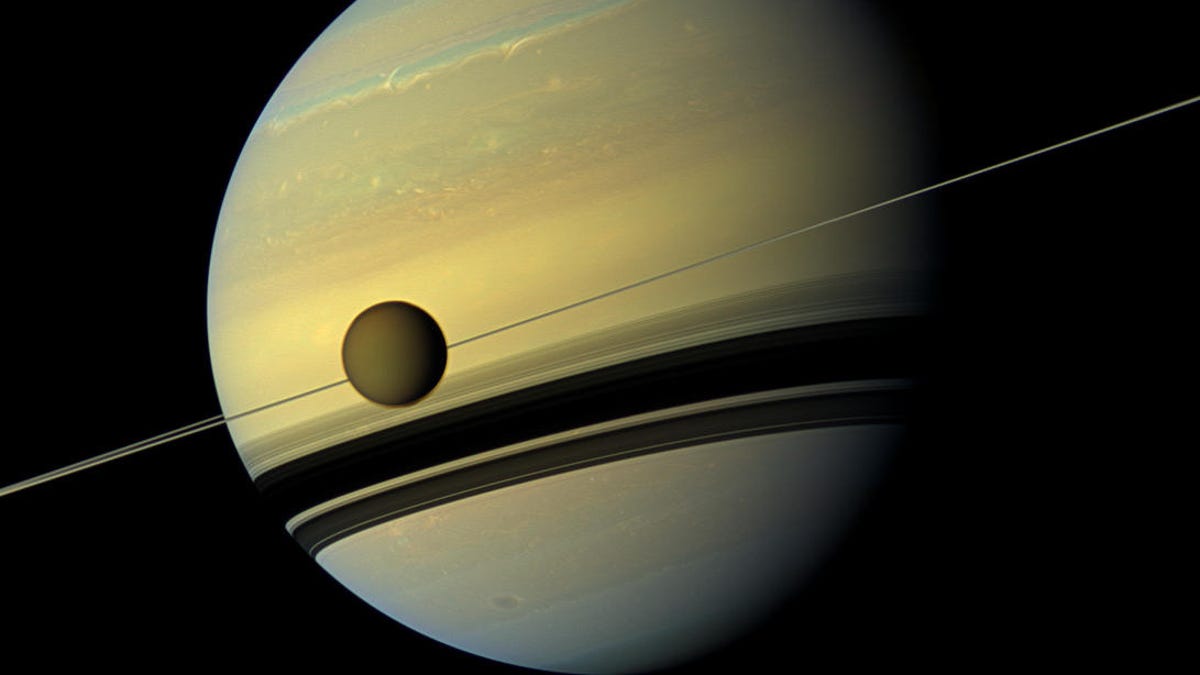The first map of Saturn's mysterious moon Titan reveals labyrinths and lakes
NASA's Cassini probe peers through the hazy methane clouds and finds a world of methane lakes, desolate plains and skyscraper-sized dunes.

Titan poses in front of Saturn in this mosaic image from the Cassini mission.
Titan, the second largest moon in the solar system, is literally shrouded in mystery. A thick layer of hazy methane clouds obscure the moon's surface and prevents an in-depth look at its important geological features. Even so, scientists have been able to peer through the clouds, thanks to some enterprising work by the Cassini probe, and they found Titan's surface is composed of huge "phantom" methane lakes. The spacecraft orbited Saturn between 2004 and 2017 and zipped past Titan more than 120 times.
Thanks to those repeat visits, Cassini's radar instruments had time to examine Titan's features, resulting in the first global geologic map of the weird, icy world.
The map, published in Nature Astronomy on Monday, identifies six key features (or "geologic units"): plains, dunes, hummocky terrain (small mountains), lakes, labyrinth terrain and craters. Titan's surface is dominated by plains across the middle latitudes, which make up approximately 65% of the total mapped area. Dunes span the length of the equator, while the poles are home to Titan's weird methane lakes.
The authors noted that the majority of Titan's lakes are situated at the north pole, while the south pole appears relatively dry. This may be the result of global climate cycles, and the distinct features across Titan suggest there are a number of processes acting on the surface of the moon, controlled by the climate, seasons and elevation.
NASA shared a complete annotated map, showing the major geologic features.
The first full geological map of Saturn's moon, Titan.
Titan is kind of like a bizarro-Earth, which raises some tantalizing prospects: Could it harbor life? And how different would that life be, thanks to the moon's unusual methane cycle? Could life, having replaced oxygen with methane, be thriving on Titan? Those are just some of the questions NASA hopes to answer in the future.
The agency plans to return to Titan in 2034 for the Dragonfly mission, which will drop a drone onto the moon's surface. The vehicle, officially dubbed a rotorcraft, will be the first NASA flying vehicle to perform a science mission on another world. It will be able to take off and touch down across Titan's landscape, with NASA hoping to cover approximately 175 kilometers (108 miles) during an initial 2.7-year study.
"The Cassini mission revealed that Titan is a geologically active world, where hydrocarbons like methane and ethane take the role that water has on Earth," David Williams, a planetary geologist at Arizona State University and co-author on the study, said in a press release. "These hydrocarbons rain down on the surface, flow in streams and rivers, accumulate in lakes and seas, and evaporate into the atmosphere. It's quite an astounding world!"

